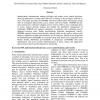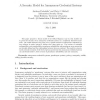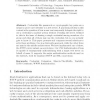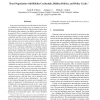110
click to vote
TRUST
2010
Springer
14 years 11 months ago
2010
Springer
Abstract. Credential platforms implemented on top of Trusted Execution Environments3 (TrEEs) allow users to store and use their credentials, e.g., cryptographic keys or user passwo...
105
click to vote
CONCURRENCY
2008
15 years 1 months ago
2008
Authorization infrastructures manage privileges and render access control decisions, allowing applications to adjust their behavior according to the privileges allocated to users....
106
click to vote
IFIP11
2004
15 years 2 months ago
2004
This paper proposes a formal model of the Bellare-Rogaway type [1] that enables one to prove the security of an anonymous credential system in a complexity theoretic framework. Th...
CCS
2000
ACM
15 years 4 months ago
2000
ACM
The Internet provides an environment where two parties, who are virtually strangers to each other, can make connections and do business together. Before any actual business starts...
CCGRID
2004
IEEE
15 years 4 months ago
2004
IEEE
Public Key Infrastructures suffer from usability and security problems associated with the request for and secure management of end user credentials. Online credential repositorie...
119
click to vote
GRID
2005
Springer
15 years 6 months ago
2005
Springer
— Jobs on the Grid require security credentials throughout their run for accessing secure Grid resources, such as GridFTP data repositories. However, delegating long-lived creden...
123
click to vote
EUROPKI
2005
Springer
15 years 6 months ago
2005
Springer
Credentials like passwords or cryptographic key pairs are a means to prove one’s identity to a web server. A practical problem in this context is the question of how a user can t...
110
click to vote
NDSS
2006
IEEE
15 years 7 months ago
2006
IEEE
In an open environment such as the Internet, the decision to collaborate with a stranger (e.g., by granting access to a resource) is often based on the characteristics (rather tha...
121
click to vote
ACNS
2008
Springer
15 years 7 months ago
2008
Springer
In the pursuit of authentication schemes that balance user privacy and accountability, numerous anonymous credential systems have been constructed. However, existing systems assume...
POLICY
2009
Springer
15 years 7 months ago
2009
Springer
A central task in the context of logic-based decentralized authorization languages is that of gathering credentials from credential providers, required by the resource guard’s p...






